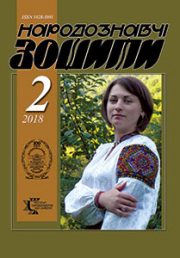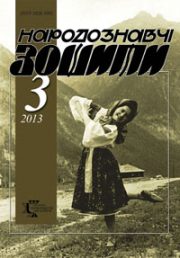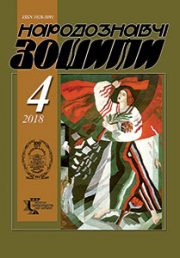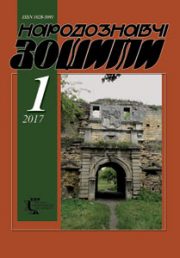2021 #1 Kalachova I.
The Ethnology Notebooks. 2021. # 1 (157), P. 46—52
УДК [94 (476—15) + 643.01 (476—15) (039)
DOI https://doi.org/10.15407/nz2021.01.046
STRUCTURE OF THE TRADITIONAL LIVING SPACE OF NORTHERN POLESIA: UTILITARIAN AND MYTHO-RITUAL ASPECTS
Iryna KALACHOVA
- ORCID ID: https://orcid.org/0000-0002-9797-6880
- Doctor of Historical Sciences, Associate professor,
- Professor at the Department of Social Communication
- Belarusian State University,
- Independence Avenue 4, Minsk, Belarus
- e-mail: edu2902900@gmail.com
The article attempts a comprehensive analysis of the structure of the traditional living space of the inhabitants of Northern Polesia. The relevance of the study is a significant expansion of the problem, which lies in the plane of the history of everyday life, an important part of which is the living conditions of the population in the system of natural and climatic conditions, economic functions and mytho-ritual content. An important scientific interest is the study of mutual influences in the sphere of everyday culture of the population of Polesia as an ethnically transitional region, a region of Ukrainian-Belarusian ethno-cultural interaction. The goal of the article is a comprehensive analysis of the structure of the traditional living space of the inhabitants of Northern Polesia in its utilitarian, mythological and ritual aspects. The object is the traditional dwelling common in Northern Polesia and its individual components, and the subject of the study is data on its layout, the utilitarian functions of individual elements, their mythological content and ritual content. The source of the study is the work of scientists, historians and ethnographers, such as P. Shpilevsky, N. Nikiforovskiy, M. Ulashchyk, A. Lakotka, U. Lobach, etc. The chronological framework is determined by the thematic focus and the task of the study and covers the period of the XIX — first half of the XX~centuries. The territorial frameworks cover the Northern (Belarusian) Polesia, which includes the territories of the modern Brest region (completely) and Gomel region (major part), as well as some southern regions of the Minsk and Grodno regions of Belarus. The methodological basis of the study was made up of general scientific principles of historical analysis. The study uses historical-comparative, typological, structural-functional methods and the method of field research.
Keywords: Polesia, traditional culture, dwelling, homestead, house, myth, ritual.
REFERENCES
- Lobach, U.А. (2013). Myth. Space. Man: the Belarusian traditional landscape in a semiotic perspective. Minsk: Technalohija [in Belarusian].
- Nikiforovskiy, N.J. (1897). Common folk signs and beliefs. Superstitious rites and customs, legendary tales about people and places. Vitebsk: Gubernskaya tipo-litografiya [in Russian].
- Lobach, U.А. (2006). Elements of the cultural landscape in the mythopoetic picture of the world of Belarusians (based on ethnographic and folklore materials of the Rechyca region). Viesnik Polackaha. dziarzhaunaha univiersiteta, 7, 2—8 [in Belarusian].
- Lokotko, А.I. (1991). Belarusian folk architecture: the middle of the XI—XX centuries. Minsk: Nauka i tekhnika [in Russian].
- Lakotka, А.І. (1999). National features of Belarusian architecture. Minsk: Uradzaj [in Belarusian].
- Andreichyk, К., & Ganski, U. (2012). Historical local studies in Belarus in the 19th century. European and national dimension in research: materials of IV researchers’ conference (Novopolotsk, april 25—26, 2012) (Part 1, pp. 86—89). Novopolotsk.
- Lakotka, А.І. (1996). Under the roofs of the forefathers. Minsk: Polymia [in Belarusian].
- Kalachova, І.І. (2019). Male and female in the traditional culture of Belarusians. Minsk: Bielaruskaja navuka [in Belarusian].
- Shein, P.V. (1890). Materials for studying the life and language of the Russian population of the North-Western Region. Sankt-Peterburg: Tipografiya Imperatorskoy Akademii nauk [in Russian].
- Lobach, U.А. (2009). Mythological semantics of homesteads and houses in the traditional worldview of Belarusians. Viesnik Viciebskaha dziarzhaunaha univiersiteta imia P.M. Masherava, 2, 40—47 [in Belarusian].
- Shpilevskiy, P. (2016). Travel through Polesia and the Belarusian Region. Minsk: Belarus [in Russian].
- Ulashchyk, М.М. (1989). There was such a village: a historical and ethnographic essay. Minsk: Mastackaja litaratura [in Belarusian].







